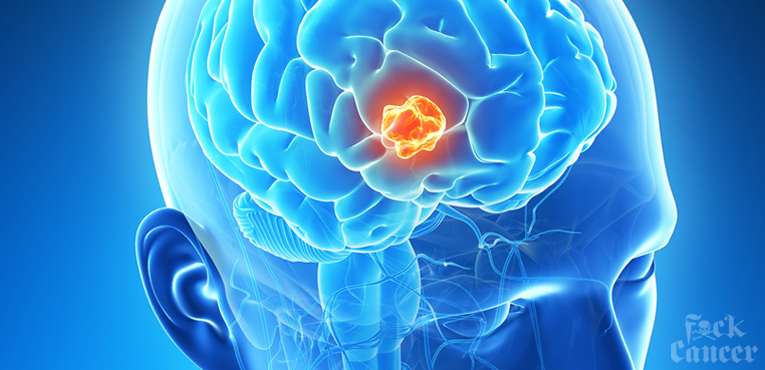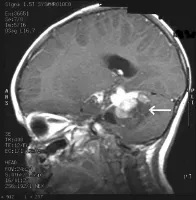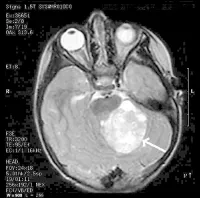
Approximately, 85,000 people will be diagnosed with a primary brain tumor in 2021 and an estimated 25,130 of those, will be diagnosed with a malignant tumor.
Types of Brain Cancer
Brain tumors are abnormal growths of cells in the brain.
- Although such growths are called brain tumors, not all brain tumors are cancer. Cancer is a term reserved for malignant tumors.
- Malignant tumors can grow and spread aggressively, overpowering healthy cells by taking their space, blood, and nutrients. They can also spread to distant parts of the body. Like all cells of the body, tumor cells need blood and nutrients to survive.
- Tumors that do not invade nearby tissue or spread to distant areas are called benign.
- In general, a benign tumor is less serious than a malignant tumor. But a benign tumor can still cause many problems in the brain by pressing on nearby tissue.
In the U.S., brain or nervous system tumors affect about 6 of every 1,000 people.
Primary Brain Cancers
The brain is made up of many different types of cells.
- Some brain cancers occur when one type of cell transforms from its normal characteristics. Once transformed, the cells grow and multiply in abnormal ways.
- As these abnormal cells grow, they become a mass, or tumor.
- The brain tumors that result are called primary brain tumors because they originate in the brain.
- The most common primary brain tumors are gliomas, meningiomas, pituitary adenomas, vestibular schwannomas, and primitive neuroectodermal tumors (medulloblastomas). The term glioma includes glioblastomas, astrocytomas, oligodendrogliomas, and ependymomas.
- Most of these are named after the part of the brain or the type of brain cell from which they arise.
Metastatic Brain Cancer
Metastatic brain tumors are made of cancerous cells from a tumor elsewhere in the body. The cells spread to the brain from another tumor in a process called metastasis. This is the most common type of brain tumor.
Causes of Brain Cancer
As with tumors elsewhere in the body, the exact cause of most brain cancer is unknown. Genetic factors, various environmental toxins, radiation to the head, HIV infection, and cigarette smoking have all been linked to cancers of the brain. In most cases, no clear cause can be shown.
Brain Cancer Scans
MRI Brain Cancer Picture: Side view section through the brain of a young girl. The white arrow shows a brain tumor that involves the brainstem.
MRI Brain Cancer Picture: Cross-section (image taken from the top of the head down) of a brain tumor in a young girl. The white arrow shows the tumor.
Brain Cancer Symptoms
Not all brain tumors cause symptoms, and some (such as tumors of the pituitary gland) are often not found unless a CT scan or MRI is done for another reason. The symptoms of brain cancer are numerous and not specific to brain tumors, meaning they can be caused by many other illnesses. The only way to know for sure what is causing the symptoms is to undergo diagnostic testing. Symptoms can be caused by:
- A tumor pressing on or encroaching on other parts of the brain and keeping them from functioning normally.
- Swelling in the brain caused by the tumor or surrounding inflammation.
The symptoms of primary and metastatic brain cancers are similar.
The following symptoms are most common:
Other nonspecific symptoms and signs include the following:
- Altered mental status — changes in concentration, memory, attention, or alertness
- Nausea, vomiting
- Abnormalities in vision
- Difficulty with speech
- Gradual changes in intellectual capacity or emotional response
In many people, the onset of these symptoms is very gradual and may be missed by both the person with the brain tumor and the family. Occasionally, however, these symptoms appear more rapidly. In some instances, the person acts as if he or she is having a stroke.
When to Seek Medical Care
Seek emergency medical help right away if you have any of the following symptoms:
- Unexplained, persistent vomiting
- Double vision or unexplained blurring of vision, especially on only one side
- Lethargy or increased sleepiness
- New seizures
- New pattern or type of headaches
Although headaches are thought to be a common symptom of brain cancer, they may not occur until late in the progression of the disease. If any significant change in your headache pattern occurs, your health care provider may suggest that you go the hospital.
If you have a known brain tumor, any new symptoms or relatively sudden or rapid worsening of symptoms warrants a trip to the nearest hospital emergency department. Be on the lookout for the following new symptoms:
- Seizures
- Changes in mental status, such as excessive sleepiness, memory problems, or inability to concentrate
- Visual changes or other sensory problems
- Difficulty with speech or in expressing yourself
- Changes in behavior or personality
- Clumsiness or difficulty walking
- Persistent nausea or vomiting (especially in middle-aged or older people)
- Sudden onset of fever, especially after chemotherapy.
Diagnosing Brain Cancer
Exams and Tests
Findings of your medical interview and physical exam will probably suggest to your health care provider that you have a problem with the brain or brain stem.
In most cases, you will have a CT scan of the brain. This test is like an X-ray, but shows more detail in three dimensions. Usually, a contrast dye is injected into your bloodstream to highlight abnormalities on the scan.
More often, the MRI scan is being used instead of a CT scan for suspected brain tumors. This is because MRI has a higher sensitivity for detecting the presence of, or changes within, a tumor. However, most institutions still use the CT scan as the first diagnostic test.
People with brain cancer often have other medical problems; therefore, routine lab tests may be performed. These include analysis of blood, electrolytes, and liver function tests.
If your mental status has been the major change, blood or urine tests may be done to detect drug use.
If your scans indicate the presence of a cancerous brain tumor, you will be referred to a cancer specialist, called an oncologist. If one is available in your area, you should be referred to a specialist in brain tumors, called a neuro-oncologist.
The next step in diagnosis is confirmation that you have a cancer, usually by taking and testing a sample of the tumor. This is called a biopsy:
- The most widely used technique for obtaining a biopsy is surgery. The skull is opened, usually with the intention of removing the whole tumor, if possible. A biopsy is then taken from the tumor.
- If the surgeon is unable to remove the entire tumor, a small piece of the tumor is removed.
- In some cases, it is possible to collect a biopsy without opening the skull. The exact location of the tumor in the brain is determined by using a CT or MRI scan. A small hole is then made in the skull and a needle guided through the hole to the tumor. The needle collects the biopsy and is removed. This technique is called stereotaxis, or stereotactic biopsy.
- The biopsy is examined under a microscope by a pathologist (a doctor who specializes in diagnosing diseases by looking at cells and tissues).
Brain Cancer Treatment
Treatment for a brain tumor differs depending on several factors: a person’s age, general health, and the size, location, and type of tumor.
You and your loved ones will have many questions about brain cancer, the treatment, side effects, and the long-term outlook. Your health careteam is the best source of this information. Don’t hesitate to ask.
Treatment Overview
Treatment of brain cancer is usually complex. Most treatment plans involve several consulting doctors.
- The team of doctors includes neurosurgeons (specialists in the brain and nervous system), oncologists, radiation oncologists (doctors who practice radiation therapy), and, of course, your primary health care provider. Your team may also include a dietitian, a social worker, a physical therapist, and, possibly, other specialists such as a neurologist.
- The treatment protocols vary widely according to the location of the tumor, its size and type, your age, and any additional medical problems that you may have.
- The most widely used treatments are surgery, radiation therapy, and chemotherapy. In most cases, more than one of these is used.
Surgery
Many people with a brain tumor undergo surgery.
- The purpose of surgery is to confirm that the abnormality seen during testing is indeed a tumor and to remove the tumor. If the tumor cannot be removed, the surgeon will take a sample of the tumor to identify its type.
- In some cases, mostly in benign tumors, symptoms can be completely cured by surgical removal of the tumor. The neurosurgeon will attempt to remove all the tumor when possible.
You may undergo several treatments and procedures before surgery. For example:
- You may be given a steroid drug, such as dexamethasone (Decadron), to relieve swelling.
- You may be treated with an anticonvulsant drug to relieve or prevent seizures.
- If you have excess cerebrospinal fluid collecting around the brain, a thin, plastic tube called a shunt may be placed to drain the fluid. One end of the shunt is placed in the cavity where fluid collects; the other end is threaded under your skin to another part of the body. The fluid drains from the brain to a site from which the fluid can be easily eliminated.
Radiation Therapy
Radiation therapy (also called radiotherapy) is the use of high-energy rays to kills tumor cells, thereby stopping them from growing and multiplying.
- Radiation therapy may be used for people who cannot undergo surgery. In other cases, it is used after surgery to kill any tumor cells that may remain.
- Radiation therapy is a local therapy. This means that it affects only cells in its path. It typically does not harm cells elsewhere in the body or even elsewhere in the brain.
Radiation can be given in the following ways:
- External radiation uses a high-energy beam of radiation targeted at the tumor. The beam travels through the skin, the skull, healthy brain tissue, and other tissues to get to the tumor. The treatments are usually given five days a week for a certain amount of time. Each treatment takes only a few minutes.
- Internal or implant radiation uses a tiny radioactive capsule that is placed inside the tumor itself. The radiation emitted from the capsule destroys the tumor. The radioactivity of the capsule decreases a little bit each day and is carefully calculated to run out when the optimal dose has been given. You need to stay in the hospital for several days while receiving this treatment.
- Stereotactic radiosurgery is sometimes called a “knifeless” surgical technique, though it does not involve surgery. It destroys a brain tumor without opening the skull. A CT or MRI scan is used to pinpoint the exact location of the tumor in the brain. A single large dose of high-energy radiation beams are trained on the tumor from different angles. The radiation destroys the tumor. Stereotactic radiosurgery has fewer complications than open surgery and a shorter recovery time.
Chemotherapy
Chemotherapy is the use of powerful drugs to kill tumor cells.
- A single drug or a combination of drugs may be used.
- The drugs are given by mouth or through an IV line. Some medications are given through the shunt put in place to drain excess fluid from the brain.
- Chemotherapy is usually given in cycles. A cycle consists of a short period of intensive treatment followed by a period of rest and recovery. Each cycle lasts a few weeks.
- Most regimens are designed so that two to four cycles are completed. There is then a break in the treatment to see how your tumor has responded to the therapy.
- The side effects of chemotherapy are well known. They may be very difficult to tolerate for some people. They may include nausea and vomiting, mouth sores, loss of appetite, loss of hair, among others. Some of these side effects can be relieved or improved by medication.
New Treatments
New therapies for cancer are being developed all the time. When a therapy shows promise, it is studied in a lab and improved as much as possible. It is then tested in clinical trials involving people with cancer.
Through brain cancer clinical trials, researchers test the effects of new medications on a group of volunteers with brain cancer. Patients with brain cancer may be reluctant to take part in clinical trials for fear of getting no treatment at all for their brain cancer.
- Clinical trials are available for virtually every kind of cancer.
- The advantage of clinical trials is that they offer new therapies that may be more effective than existing therapies or have fewer side effects.
- The disadvantage is that the therapy has not been proven to work or may not work in everyone.
- Many people with cancer are eligible for participation in clinical trials.
- To find out more, ask your oncologist. A list of clinical trials is available at the web site of the National Cancer Institute.
To learn more about clinical trials for brain cancer, see Brain Cancer Clinical Trials.
Follow-Up
Once a brain tumor is diagnosed, you need to be very careful to keep all appointments with consultants and your primary health care provider. People with brain cancer often are at increased risk for additional medical problems and, potentially, recurrence of cancer or a worsening of their symptoms.
Survival Rate
Survival rates in brain cancer vary widely. The major factors that influence survival are the type of cancer, its location, whether it can be surgically removed or reduced in size, your age, and other medical problems.
- In general, younger patients have a better prognosis.
- Brain cancer that has spread (or metastasized) from somewhere else in the body is the most common type. Survival rates depend on the original cancer and other factors.
Treatment for most types of brain cancer is available and will often give you a better chance of survival. Discuss treatment options and best-estimated prognosis with your cancer team.
Support Groups and Counseling
Living with cancer presents many new challenges, both for you and for your family and friends.
- You will probably have many worries about how the cancer will affect you and your ability to “live a normal life;” that is, to care for your family and home, to hold your job, and to continuing the friendships and activities you enjoy.
- Many people feel anxious and depressed. Some people feel angry and resentful; others feel helpless and defeated.
For most people with cancer, talking about their feelings and concerns helps.
- Your friends and family members can be very supportive. They may be hesitant to offer support until they see how you are coping. Don’t wait for them to bring it up. If you want to talk about concerns, let them know.
- Some people don’t want to “burden” their loved ones, or prefer talking about their concerns with a more neutral professional. A social worker, counselor, or member of the clergy may be helpful if you want to discuss feelings and concerns about having cancer. Your oncologist should be able to recommend someone.
- Many people with cancer are helped profoundly by talking to other people who have cancer. Sharing concerns with others who have been through the same experience can be remarkably reassuring. Support groups of people with cancer may be available through the medical center where you are receiving treatment. The American Cancer Society also has information about support groups all over the U.S.
.
.
.
.
.
Source: WebMD, Brain Cancer Types, https://www.webmd.com/cancer/brain-cancer/brain-cancer, October 9, 2019
Source: WebMD, Brain Cancer Symptoms, https://www.webmd.com/cancer/brain-cancer/brain-cancer-symptoms, January 18, 2020
Source: WebMD, Diagnosing Brain Cancer, https://www.webmd.com/cancer/brain-cancer/brain-cancer-diagnosis, January 13, 2019
Source: WebMD, Brain Cancer Treatment, https://www.webmd.com/cancer/brain-cancer/brain-cancer-treatment#4, February 10, 2020
fuck cancer, fxck cancer, f cancer, fuck cancer foundation, fxck cancer foundation, f cancer foundation, cancer awareness, cancer prevention, cancer detection, cancer education
